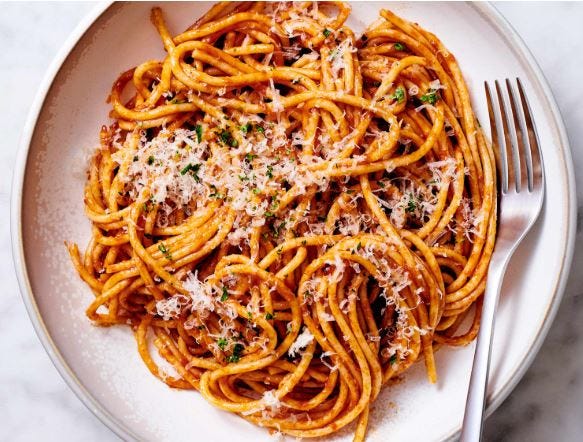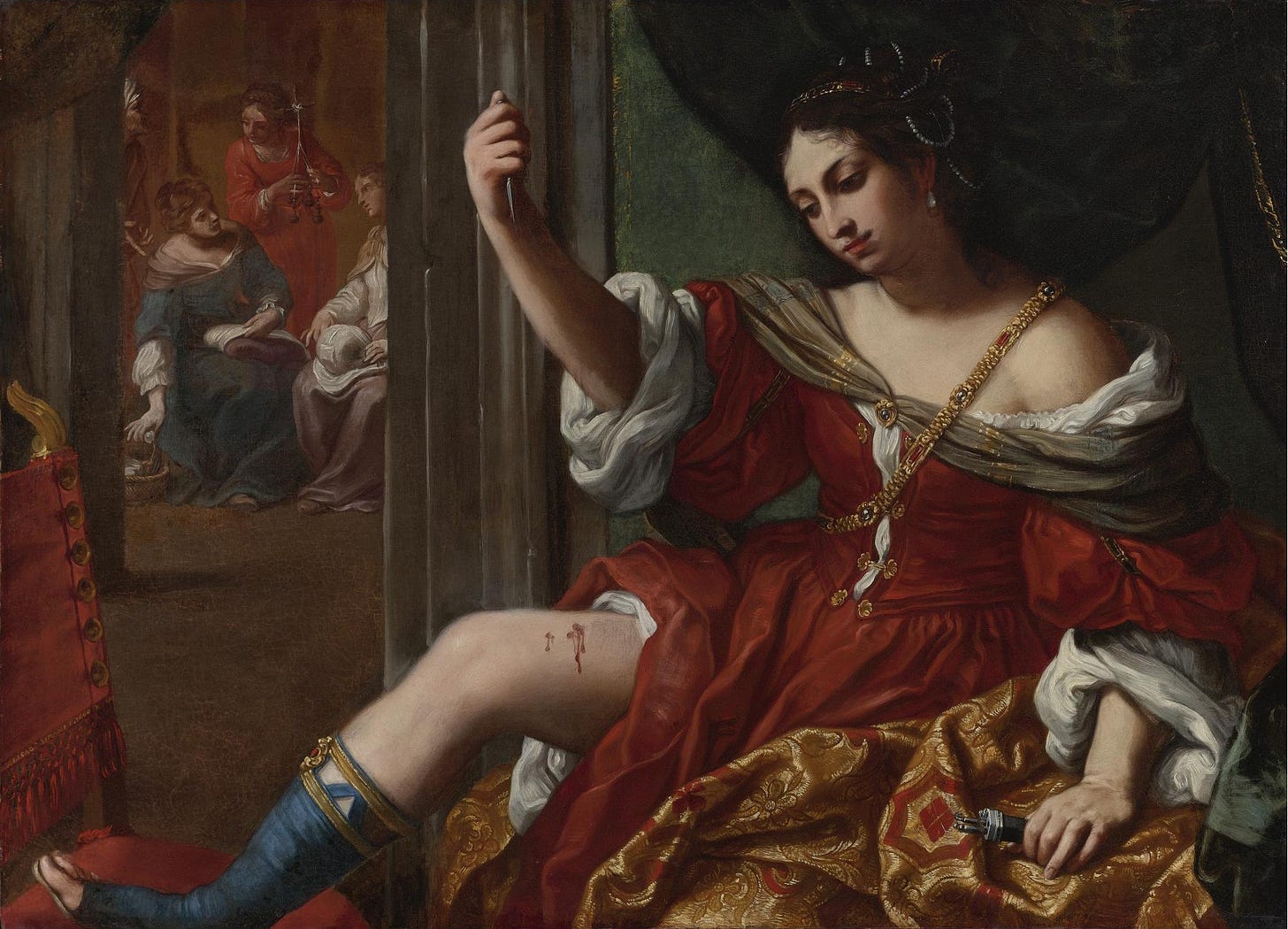Uncultured Swine, I fear you’ve been reading the newsletter of a fraud.
It’s taken me fifteen years to come out as an a..a..artist, and since entering the scene I’ve become insatiable. I read any book with the words ‘Art, Artists, Art History’ in the title, and have enrolled in art history courses - not for the credits - to genuinely learn about it. Writer/Photographer Lee Miller called these acute obsessions a ‘jag’. But the jag is up. Because, while I want to know everything there is to know about art before perishing from imminent climate catastrophe, I can’t bring myself to give two f*cks about the renaissance.
Truly, if you were to ask me what the best Italian exports are, I’d say it’s between Damiano David or pasta - al dente, of course.


As an artist I feel I’m supposed to pay dues to my predecessors - and I have tried. I’ve attempted to learn about the many-pronged sausage fest that was the renaissance: The Fall of Constantinople, Medici family, A proto-renaissance where some c*nt painted with oil instead of eggs, science?? but I get so bored I start wondering if I can, in fact, lick my elbow (I can’t). I simply do not have the time nay won’t make the time to learn any of the aforementioned references.
Now, if you were to tell me there was a group of female renaissance artists, in a city predominantly populated by women, because of a cult formed around a mummified nun? That, I’d be interested in. Mercifully, this is exactly what happened in the city of Bologna in the sixteenth and seventeenth centuries.
~

The Other Renaissance
In Women, Art and Society art historian Whitney Chadwick titled the women’s involvement in the Renaissance The Other Renaissance, though she was cautious with this phrasing, prefacing:
“There is, on the one hand, a danger of rewriting women’s production in ways that ‘fit them into’ pre-existing categories; and on the other, the risk of trivialising women’s achievements by seeing them through the lens of sexual difference.”
Which was a classy way for Chadwick, and now I, to cover our arses as we go on to do both those things.
As is true of most things women, the Other renaissance came second and largely off the women’s own steam. The 1490’s saw the m*le High Renaissance hit its stride, Leonardo da Vinci, Michelangelo and later, Raphael, came to define this period of Greek/Roman revival, humanism and a renewed interest in classical literature. Using a high speed communication system known as word of mouth, it took about half a century for this Florentine bronaissance to infiltrate the ladies of Bologna.
It wasn’t the renaissance movement that created this grouping of Bolognese women in art; it was, for the most part, a corpse. Because forty years prior to the bronaissance, an enigmatic nun named Caterina dei Vigri was appointed abbess of a new convent in Bologna. She quickly gained a reputation as a well educated woman, and importantly, a skilful artist. The level of this skill however remains unknown, as most of her art is now lost, and the few surviving pieces are, according to legitimate female art historians, a bit shit.
Regardless, the city worshipped her both during her lifetime and beyond, having her corpse publicly enshrined at a chapel you can still visit today (can’t even sleep when she’s dead). Dei Vigri’s, now St Catherine of Bologna’s, artistic influence on nuns, as well as an established history of female attendance at the University of Bologna, made the city comparatively progressive on female artists. And what gives us this rare window into their potential had women been allowed to participate in art much, much earlier.
One such Bolognese artist was so accomplished, even m*le critics of the time acknowledged her existence. Properzia de’ Rossi was a sculptor active in the early 1500s and was unique to other female artists in that she wasn’t a nepo-baby, her father neither a painter nor sculptor, and as such her artistic education is largely a mystery. Aside from her marble relief, Joseph and Potipher's Wife, 1525-26 (above), de’ Rossi is most known as one of the earliest recorded pissed off women.
Historians today consider her allegedly volatile personality as ‘transgressive.’ But de’ Rossi was woefully underpaid for her hard won commissions, then slut-shamed for sculpting a biblical reference of a lustful woman, depicted countless times by m*le artists. Any rational woman would throw paint and scratch out the eyes of her m*le colleague (allegedly) under those circumstances. In fact, it’s encouraged.
After de’ Rossi’s death in 1530 and her -ahem- legacy, of the 68 recorded female artists in Bologna in that period, there wasn’t another sculptor for 200 years. A less controversial renaissance artist (though by no means typical) was nepotism sweetheart, Lavinia Fontana (above). Born to an established artist in Bolonga in 1552, Fontana was tutored from an early age by her father before being formally educated at the city’s university.
Though women weren’t allowed to use nude models to study form, Fontana’s skill showed no handicap, as seen in Portrait of Bianca degli Utili Maselli and Her Children (above) where she recreates her subjects and their fripperies with uncanny precision. The shero also operated her own studio (believed to be the first female to do so), offered her own employment instead of a dowry, kept ‘Fontana’ in her signature after marriage, and gave birth to eleven children. Sources mention that her husband also did stuff. Sometimes Fontana let him paint the draperies.
Women who didn’t have an artistic father could take another creative route: becoming a nun. As publishing houses evolved around the university in the thirteenth to fourteenth centuries, so did the involvement of female wood carvers and miniaturists. Notables included a Carmelite nun named Sister Allegra, and another woman identified as Diana Mantuana (or Scultori), who was granted rare papal privilege to make and sell prints under her name. If I were a gambling woman, I’d bet this points to other female printmakers who’s work went unattributed, and will remain so, because this was a long, long time ago and these women are now dead.
Another artist who embraced #MonkMode was Plautilla Nelli (1524 – 1588). Nun Nelli was a rare Florentine female artist who, despite being wed to Jesus for 50 years, was no saint. She started an female only workshop at her convent, and was one of few women who painted ambitious biblical scenes to the chagrin of m*le art institutions. Her depiction of The Last Supper (above) maybe isn’t as iconic as da Vinci’s, but is remarkable considering she was self taught and likely used other nuns as models.
Though this painting, or Fontana’s work or de Rossi’s, still look, unfortunately, like most other renaissance art, it’s hard not to draw a line between their early resistance and Artemisia Gentileschi’s Judith Slaying Holofernes (16140-20), Portia Wounding Her Thigh (1664) by Elisabetta Sirani (top) or Sabrina Carpenter’s Man’s Best Friend album cover. Which is why it’s surprising that, though I can read Leonardo da Vinci’s literal grocery list, what’s known about these pioneering women barely fills a book.
And thank god for that. Because if there’s one thing I treasure in histories of really fucking old dead renaissance people, it’s brevity.
~
M*n take note.
If you made it to the end with your well-being intact, thank you, and you’ve done better than me. I hope I made this research heavy topic at least partially readable????
If you want to learn more about mwa or see even LESS of me than you do on here, follow me (@)maggijeann on instagram.
Thanks Grace for being an editor but not this time because I went rogue and have certainly made mistakes, see you next TUESDAYYYYYY xxoooxo Maggie Jean
References:
Women, Art and Society (1990) by Whitney Chadwick
The Story of Art Without Men (2022) by Katy Hessel








